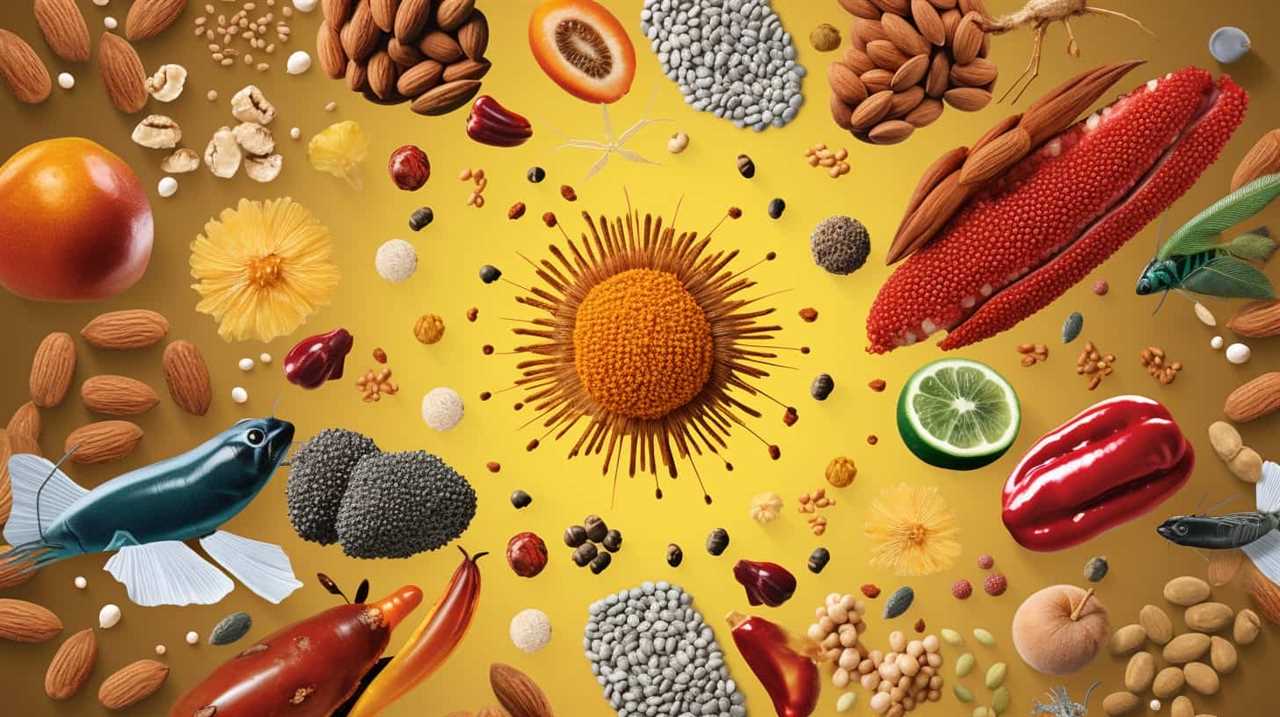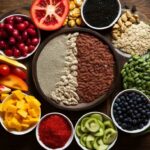We’ve explored the mysteries of the powerful seed powerhouse, delving into its history to uncover a narrative that has never been told before.
Brace yourselves for an eye-opening journey through time as we explore the ancient origins, cultural significance, and modern-day applications of the incredible chia seed.
From its revered status in Mesoamerican culture to its medicinal and ritualistic uses, this unassuming seed has a history that will leave you in awe.
Prepare to be amazed by the power of the chia seed.

Key Takeaways
- Chia seeds have been a staple in ancient diets for thousands of years, recognized for their nutritional value and versatility.
- Chia seeds held cultural significance in Mesoamerica, symbolizing life, fertility, and strength.
- Chia seeds are packed with essential nutrients and can be easily incorporated into various recipes.
- Chia seeds have experienced a resurgence in recent years due to their nutritional benefits and can be a valuable addition to a healthy diet.
Ancient Origins of Chia Seeds
In our exploration of the ancient origins of chia seeds, we journey back in time to uncover the origins of this seed powerhouse.
Chia seeds have been a staple in ancient diets for thousands of years, with historical evidence of their cultivation dating back to civilizations such as the Aztecs and Mayans.
These ancient cultures recognized the incredible nutritional value and versatility of chia seeds, incorporating them into their daily meals.
Chia seeds were highly regarded for their ability to provide sustained energy, improve endurance, and promote overall wellness.

The historical cultivation of chia seeds showcases the wisdom of these ancient civilizations in harnessing the power of nature’s gifts.
As we delve deeper into the topic of chia seeds in Mesoamerican culture, we’ll uncover the fascinating traditions and beliefs that surrounded these remarkable seeds.
Chia Seeds in Mesoamerican Culture
Let’s delve into the rich cultural significance of chia seeds in Mesoamerica and unravel their ancient traditions and beliefs.
Chia seeds held a prominent place in Mesoamerican folklore, where they were believed to possess spiritual significance. These tiny seeds were considered a symbol of life and fertility, often associated with deities and rituals.

Mesoamerican cultures believed that consuming chia seeds would grant them strength, endurance, and vitality. They were also used in various religious ceremonies and offerings to honor the gods.
Chia seeds were deeply ingrained in the cultural fabric of Mesoamerica, reflecting the importance of agriculture and the connection between humans and the natural world.
As we explore further, we’ll discover how these sacred seeds transcended their spiritual significance to become a staple food in Mesoamerican cuisine.
Chia Seeds as a Staple Food
Chia seeds held such cultural significance in Mesoamerica that they became a staple food for the indigenous populations, providing them with nourishment and sustenance. These tiny seeds weren’t only revered for their cultural significance but also for their nutritional benefits.

Chia seeds are packed with essential nutrients, including omega-3 fatty acids, fiber, protein, and antioxidants. They’re low in calories and can be easily incorporated into various recipes. Chia seed recipes have become increasingly popular in recent years due to their versatility and health benefits.
From chia seed puddings and smoothies to chia seed energy bars and baked goods, there are countless ways to enjoy the nutritional benefits of chia seeds. Incorporating these nutrient-dense seeds into our diets can support overall health and well-being, making them an excellent addition to any meal.
Chia Seeds in Medicine and Rituals
Exploring the rich cultural heritage of Mesoamerica, we uncover the intriguing role of chia seeds in ancient medicine and rituals. Chia seeds have long been recognized for their medicinal properties and were used in alternative medicine to treat various ailments. These tiny seeds were believed to possess healing powers and were often consumed to promote physical and mental well-being. Additionally, chia seeds played a significant role in spiritual practices and rituals. They were used in ceremonies and offerings, symbolizing fertility, abundance, and spiritual growth. The spiritual significance of chia seeds can be seen in their use in rituals related to harvest, fertility, and purification. The table below highlights some of the ways chia seeds were used in medicine and rituals in Mesoamerican cultures.
| Chia Seeds in Alternative Medicine | Chia Seeds in Spiritual Practices |
|---|---|
| Used to treat digestive disorders | Used in ceremonies and offerings |
| Believed to enhance energy levels | Symbolized fertility and abundance |
| Consumed for their anti-inflammatory properties | Associated with spiritual growth |
| Applied topically to promote healing | Used in rituals related to harvest, fertility, and purification |
Rediscovery and Modern Uses of Chia Seeds
After exploring the rich cultural heritage of Mesoamerica and uncovering the intriguing role of chia seeds in ancient medicine and rituals, we now turn our attention to the rediscovery and modern uses of this seed powerhouse.

Chia seeds have experienced a remarkable resurgence in recent years, as their nutritional benefits and culinary uses have gained recognition. These tiny seeds are packed with fiber, protein, and omega-3 fatty acids, making them a valuable addition to any diet. They can be easily incorporated into a variety of dishes, including smoothies, salads, and baked goods, adding a nutritious boost to meals.
Additionally, chia seeds can be used as a vegan egg substitute in baking, making them a versatile ingredient for those with dietary restrictions. With their rediscovery and modern uses, chia seeds have become a staple in many health-conscious kitchens, offering a convenient and nutritious way to support overall well-being.
Frequently Asked Questions
How Were Chia Seeds First Discovered and Used in Ancient Times?
Chia seeds, discovered in ancient times, have been utilized in modern cuisine for their numerous nutritional benefits. We explore the fascinating history behind their initial discovery and usage, shedding light on this seed powerhouse.
What Role Did Chia Seeds Play in the Daily Lives of Mesoamerican Civilizations?
Chia seeds were a vital source of energy for mesoamerican civilizations. They were incorporated into their daily lives, providing sustenance and nourishment. Today, chia seeds continue to be an essential part of modern diets.

How Did Chia Seeds Become a Staple Food in Certain Regions?
Chia seeds became a staple food in certain regions due to their cultivation and nutritional value. Their adaptability to different climates and high protein, fiber, and omega-3 content made them a valuable resource for sustaining communities.
Were Chia Seeds Used for Medicinal Purposes or in Rituals in Ancient Cultures?
Chia seeds were indeed used for medicinal purposes and in rituals in ancient cultures. Their medicinal uses ranged from promoting digestion to treating skin conditions, while their ritual significance varied across different societies.
How Did Chia Seeds Fall Out of Use and How Were They Rediscovered for Modern Consumption?
Chia seeds, with their historical significance, have experienced a remarkable journey. Rediscovered for modern consumption, their fall from use remains a mystery. We delve into the untold story of how chia seeds made their way back into our diets.
Conclusion
In the depths of history, the untold story of the seed powerhouse known as chia seeds has finally been revealed. From their ancient origins to their significance in Mesoamerican culture, chia seeds have been a staple food, a medicine, and a part of sacred rituals.

Through centuries of obscurity, they’ve now resurfaced as a modern superfood. Like a hidden treasure unearthed, chia seeds have the power to nourish and heal, connecting us to our ancient past.
















